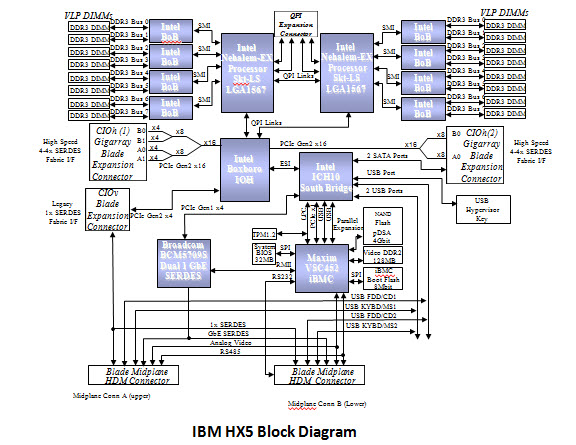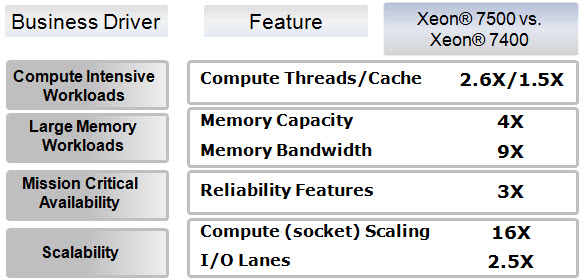Today, Dell announced the addition of 3 new blade servers to its PowerEdge portfolio – the PowerEdge M820, PowerEdge M520 and the PowerEdge M420. Each server offers a unique addition to the Dell blade server family and will be available soon.
Category Archives: Intel
Virtualization Performance on Blade Servers
One of the industry-leading independent technology assessment service firms, Principled Technologies, just updated their site with a ton of white papers covering performance on just about any product or technology. You can check out their website at http://www.principledtechnologies.com/default.htm for the complete list, but I wanted to give you the links to their papers that cover virtualization performance on blade servers.
Intel Announces Sandy Bridge, aka Xeon E5-2600
Intel announced on Tuesday their next generation of 2 socket CPU – the Intel Xeon E5-2600. Formerly code named, “Sandy Bridge,” the E5-2600 is a follow on to the Intel Xeon 5600 series family and offers a real performance increase. In fact, Intel is boasting performance increases from 43% to 62% (depending on the vendor and benchmark.) What is contributing to this massive increase in performance? Let’s take a look.
A Look at Intel’s Cloud Builders Initiative
In case you haven’t heard, “cloud” discussions are here to stay and everyone has their own recommendations for you to start building your cloud environment, but which is best for you? Intel has created the “Intel® Cloud Builders” program aimed at making it easier for you to build, enhance and operate cloud infrastructure.
A Look at the Dell PowerEdge M610 Blade Server
 Intel and Dell recently agreed to provide me with a Dell PowerEdge M610 blade server for me to use in my lab, so I thought I’d take advantage of the opportunity and write-up a review. I’m going to go into further details about the blade server in the following blog post, but here are the high-level quick specs:
Intel and Dell recently agreed to provide me with a Dell PowerEdge M610 blade server for me to use in my lab, so I thought I’d take advantage of the opportunity and write-up a review. I’m going to go into further details about the blade server in the following blog post, but here are the high-level quick specs:
Intel Announces New Xeon 4 Socket CPU (E7); Dell, HP and IBM Slated to Refresh Blades
UPDATED 11:30 a.m. EST (4/6/11) – Intel announced today the next version of their 4 socket chipset, known as “E7”. Previously known with the codename of Westmere EX, the newly released Xeon 7600 will be rebranded as the Intel Xeon E7. Continue reading
2011 – The Year of the Intel CPU
It’s no surprise that Intel will be release a few new lines of CPUs this year, but in today’s post I thought I’d take a few minutes to highlight some of the details. Continue reading
Technical Details on the IBM HX5 Blade Server (UPDATED)
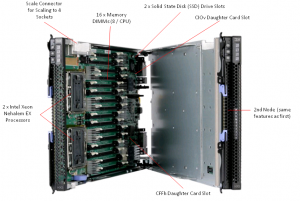 (Updated 4/22/2010 at 2:44 p.m.)
(Updated 4/22/2010 at 2:44 p.m.)
IBM officially announced the HX5 on Tuesday, so I’m going to take the liberty to dig a little deeper in providing details on the blade server. I previously provided a high-level overview of the blade server on this post, so now I want to get a little more technical, courtesy of IBM. It is my understanding that the “general availability” of this server will be in the mid-June time frame, however that is subject to change without notice.
Block Diagram
Below is the details of the actual block diagram of the HX5. There’s no secrets here, as they’re using the Intel Xeon 6500 and 7500 chipsets that I blogged about previously.
As previously mentioned, the value that the IBM HX5 blade server brings is scalability. A user has the ability to buy a single blade server with 2 CPUs and 16 DIMMs, then expand it to 40 DIMMs with a 24 DIMM MAX 5 memory blade. OR, in the near future, a user could combine 2 x HX5 servers to make a 4 CPU server with 32 DIMMs, or add a MAX5 memory DIMM to each server and have a 4 CPU server with 80 DIMMs.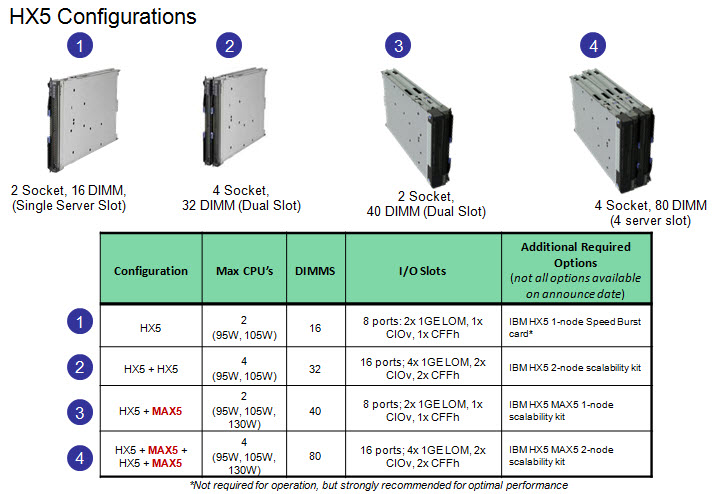
The diagrams below provide a more technical view of the the HX5 + MAX5 configs. Note, the “sideplanes” referenced below are actualy the “scale connector“. 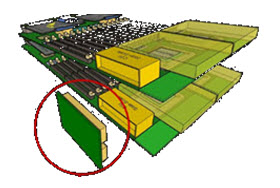 As a reminder, this connector will physically connect 2 HX5 servers on the tops of the servers, allowing the internal communications to extend to each others nodes. The easiest way to think of this is like a Lego . It will allow a HX5 or a MAX5 to be connected together. There will be a 2 connector, a 3 connector and a 4 connector offering.
As a reminder, this connector will physically connect 2 HX5 servers on the tops of the servers, allowing the internal communications to extend to each others nodes. The easiest way to think of this is like a Lego . It will allow a HX5 or a MAX5 to be connected together. There will be a 2 connector, a 3 connector and a 4 connector offering.
(Updated) Since the original posting, IBM released the “eX5 Porfolio Technical Overview: IBM System x3850 X5 and IBM BladeCenter HX5” so I encourage you to go download it and give it a good read. David’s Redbook team always does a great job answering all the questions you might have about an IBM server inside those documents.
If there’s something about the IBM BladeCenter HX5 you want to know about, let me know in the comments below and I’ll see what I can do.
Thanks for reading!
Details on Intel’s Nehalem EX (Xeon 7500 and Xeon 6500)
Intel is scheduled to “officially” announce today the details of their Nehalem EX CPU platform, although the details have been out for quite a while, however I wanted to highlight some key points.
 Intel Xeon 7500 Chipset
Intel Xeon 7500 Chipset
This chipset will be the flagship replacement for the existing Xeon 7400 architecture. Enhancements include:
•Nehalem uarchitecture
•8-cores per CPU
•24MB Shared L3 Cache
• 4 Memory Buffers per CPU
•16 DIMM slots per CPU for a total of 64 DIMM slots supporting up to 1 terabyte of memory (across 4 CPUs)
•72 PCIe Gen2 lanes
•Scaling from 2-256 sockets
•Intel Virtualization Technologies
Intel Xeon 6500 Chipset
 Perhaps the coolest addition to the Nehalem EX announcement by Intel is the ability for certain vendors to cut the architecture in half, and use the same quality of horsepower across 2 CPUs. The Xeon 6500 chipset will offer 2 CPUs, each with the same qualities of it’s bigger brother, the Xeon 7500 chipset. See below for details on both of the offerings.
Perhaps the coolest addition to the Nehalem EX announcement by Intel is the ability for certain vendors to cut the architecture in half, and use the same quality of horsepower across 2 CPUs. The Xeon 6500 chipset will offer 2 CPUs, each with the same qualities of it’s bigger brother, the Xeon 7500 chipset. See below for details on both of the offerings.
Additional Features
Since the Xeon 6500/7500 chipsets are modeled off the familiar Nehalem uarchitecture, there are certain well-known features that are available. Both Turbo Boost and HyperThreading have been added to the and will provide users for the ability to have better performance in their high-end servers (shown left to right below.)
Memory
Probably the biggest winner of the features that Intel’s bringing with the Nehalem EX announcement is the ability to have more memory and bigger memory pipes. Each CPU will have 4 x high speed “Scalable Memory Interconnects” (SMI’s) that will be the highways for the memory to communicate with the CPUs. As with the existing Nehalem architecture, each CPU has a dedicated memory controller that provides access to the memory. In the case of the Nehalem EX design, each CPU has 4 pathways that each have a Scalable Memory Buffer, or SMB, that provide access to 4 memory DIMMs. So, in total, each CPU will have access to 16 DIMMs across 4 pathways. Based on the simple math, a server with 4 CPUs will be able to have up to 64 memory DIMMs. Some other key facts:
Each CPU will have 4 x high speed “Scalable Memory Interconnects” (SMI’s) that will be the highways for the memory to communicate with the CPUs. As with the existing Nehalem architecture, each CPU has a dedicated memory controller that provides access to the memory. In the case of the Nehalem EX design, each CPU has 4 pathways that each have a Scalable Memory Buffer, or SMB, that provide access to 4 memory DIMMs. So, in total, each CPU will have access to 16 DIMMs across 4 pathways. Based on the simple math, a server with 4 CPUs will be able to have up to 64 memory DIMMs. Some other key facts:
• it will support up to 16GB DDR3 DIMMs
•it will support up to 1TB with 16GB DIMMS
•it will support DDR3 DIMMs up to 1066MHz, in Registered, Single-Rank, Dual-Rank and Quad-Rank flavors.
Another important note is the actual system memory speed will depend on specific processor capabilities (see reference table below for max SMI link speeds per CPU):
•6.4GT/s SMI link speed capable of running memory speeds up to 1066Mhz
•5.86GT/s SMI link speed capable of running memory speeds up to 978Mhz
•4.8GT/s SMI link speed capable of running memory speeds up to 800Mhz
Here’s a great chart to reference on the features across the individual CPU offerings, from Intel:
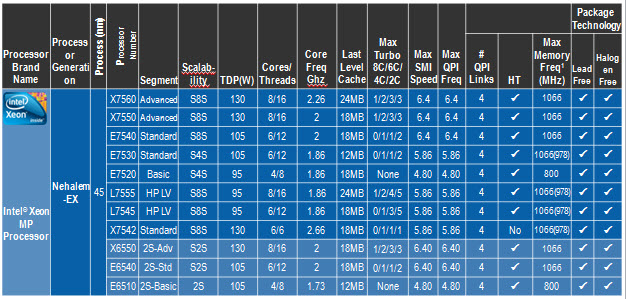
Finally, take a look at some comparisons between the Nehalem EX (Xeon 7500) and the previous generation, Xeon 7400:
That’s it for now. Check back later for more specific details on Dell, HP, IBM and Cisco’s new Nehalem EX blade servers.
